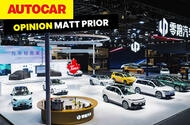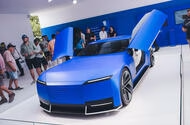How Shared Car Platforms Are Quietly Revolutionizing What Drives Us
 More than 40 million cars on the MQB platform have been built – not all carrying a VW badge
More than 40 million cars on the MQB platform have been built – not all carrying a VW badge
There was a time when bosses at car manufacturers didn’t like to talk about platforms – the mechanical underpinnings of their cars.
These are expensive to develop, so big car companies share them across brands, and bosses used to think that it might be perceived as bad news if the public knew that a cheap car was largely the same underneath as an expensive one. So they preferred to keep schtum.
The really difficult and pricey bit to develop was – and still is, most notably in cars with engines – the area between the front wheels and the driver, because largely everything substantial goes into it.
There’s the engine itself, of course, plus the transmission, while behind it is the dashboard and everything that entails, including a whole heap of the electronics – more electronics than ever. Behind it is, put in very crude terms, something a car is just dragging around. So the same platform can host many different lengths of car.
That whole area is where the hard work goes. It has to be compact enough that a driver can see over the top of it. The structure around it has to be rigid enough to properly support the suspension and strong enough to support the forces flowing from the doors in a side impact. And yet it needs to be flexible enough to absorb frontal impacts without forcing the whole shebang into the passenger compartment.
More recently, it’s where loads of active safety and convenience equipment – sensors, cameras and more – have had to be mounted too.
Throwing in the fact that engines and gearboxes are now far more complex than ever means this part of a combustion-engined car is by some distance the most critical and expensive bit, so if a car maker can engineer it once and use it multiple times, so much the better.
Whatever decisions a manufacturer makes in this area therefore defines a raft of models. But thinking that customers wouldn’t necessarily appreciate knowing that, they didn’t always want to talk about it.
It turns out, though, that the car buying public doesn’t care that much at all if what lives beneath, say, their Audi is similar to what lives beneath their Skoda. I’ve heard people say “it’s basically a Volkswagen underneath” about a Skoda to convince themselves they’ve got a well-engineered budget car.
But I don’t think I’ve heard someone say the same about their Porsche Cayenne. They seem contented that Porsche has done extra work somewhere and that it was worth paying for.
And since it turns out that few people seem to care either way, in my experience car makers today seem less guarded about talking platforms and architectures than they used to be.
That has made it much easier to talk to designers and engineers about their cars. It has helped them to explain new models and helped us understand them. It has also (and it’s possible that they like this less) made it easier to quiz them about upcoming variants, particularly when it comes to sporty versions.
If we know a particular engine fits or can make a certain amount of power, or if we know a platform has been made to accommodate four-wheel drive, then surely, engineer, you could, you know, make a GTI/R/RS/etc, couldn’t you? Do tell us more.
Sometimes that has prompted a clear answer: “Sorry, mate, that platform can’t be four-wheel drive, and it would be too expensive to engineer it differently for just a few sporty cars, so there will be no really fast variant of that car.”In the case of EVs, things aren’t quite so straightforward.
Four-wheel-drive EVs need only a motor at the back, not a driveshaft from the front. But if the rear suspension, a subframe or the body isn’t designed to accommodate one, it’s still an expensive re-engineering job.
Or rather it was. It turns out that this particular platform limitation might no longer apply. It’s suggested that the upcoming Volkswagen ID 2 R will have not only a powerful front motor but also a motor inside each rear wheel.
No room for a motor and a differential under the boot floor? No problem: in the hub it can go. I hadn’t thought about that before, but I think it basically means almost any platform could end up hosting any drive configuration that a manufacturer chooses.
The rules as we know them continue to shift.
Why Lifted Estate Cars Vanished from UK Roads and Why Drivers Still Miss Them
 What could be better for tackling the treacherous M2 than an A4 Allroad?
What could be better for tackling the treacherous M2 than an A4 Allroad?
I can’t quite believe it: there are now no lifted estate cars on sale in the UK.
With confirmation that the new Subaru Outback won’t be coming here, they’re all gone. What ever happened to the Seat Leon X-Perience, Vauxhall Insignia Country Tourer and Toyota Corolla Trek? Then there was the Skoda Octavia and Superb Scout duo, Mercedes’ All-Terrains, Volkswagen’s Alltracks, Volvo’s Cross Countrys and Audi’s Allroads.
If they’re seemingly so unpopular, why do I love them? First, a history lesson – and it starts with, of all people, the Americans. A nation of households owning multiple land yachts creating a new segment for practical compact cars.
Enter, in 1979, the AMC Eagle Wagon, with raised suspension and full-time four-wheel drive. It was another original idea from an ingenious company fighting ‘the big three’ on a shoestring. The Eagle struck a chord with buyers in rural and snow-prone areas – before being killed by Chrysler’s purchase and eventual shuttering of AMC.
Spiritual successors followed in the form of the 1994 Subaru Legacy Outback (the model that really kick-started the trend), the 1997 Volvo V70 XC and 1999’s A6-based Audi Allroad. Soon everybody was at it: Peugeot had the 508 RXH, Saab the 9-3 X and Alfa Romeo the 156 Crosswagon, to name a few more.
To me, such cars present themselves as the perfect all-rounders. That is to say, slightly more versatile estates. They combine the benefits of better handling, fuel consumption and styling with the all-terrain ability of an SUV. In fact, most of them could probably outperform the average school-run SUV on the rough stuff.
And yet despite the number on offer, they were never actually that popular. I suppose that sensible estate car customers don’t need four-wheel-drive capabilities (let’s be honest, with modern tyres, pretty much no one does) and SUV buyers like theirs purely because they enjoy sitting higher up than other road users.
As a result, they’re now all gone in this country (bar a few more months of the front-wheel-drive Ford Focus Active Estate and the six-figure Porsche Taycan Cross Turismo), and even in Europe Mercedes and Audi are the only ones still pursuing the idea.
I’m an owner of a low-slung estate who has no real need for four-wheel drive, but on the apocalyptic roads of rural-ish Kent, I regularly find myself wishing for additional suspension travel and a chunk more tyre wall.
It turns out that in today’s Britain, the perfect all-rounder is not a BMW 3 Series Touring but an Audi A4 Allroad (with a diesel V6, obviously). I’m off to Autotrader, then, while praying that Audi will bring the next A6 Allroad here.
Why Predictions of a Car Industry Shakeout Miss the Mark and Why Variety Will...
 The idea that there will only be a handful of car companies in a decade is tosh
The idea that there will only be a handful of car companies in a decade is tosh
I’m told a television programme called You Bet! still exists, which some of you might remember from the 1980s, while some others among you might not quite believe existed.
A contestant would come on – a scientist, perhaps – and tell a panel of celebrity judges that they reckoned they could do something unlikely, like tell the temperature of a jug of water to within half a degree centigrade, perhaps even more accurately, by dipping their nose in it.
I’m fairly certain that example actually happened and I’m not making it up. The judges would then bet on whether said feat was possible or not.
You would have thought not for that specific example, but from memory I think you would have been wrong. And so the show went on.
Two other examples stir my memory. Someone identifying cars from just their wheel or hubcap design. I think I stood a pretty good chance of getting most of those right at the time. And someone who thought they could tell you what any product was just from its barcode.
Barcodes must have been a fairly new thing at the time. “That’s Whiskas cat food, chicken flavour,” might have been possible in the late 1980s, but surely it wouldn’t be now, would it? And likewise the proliferation of wheels and wheel designs means that I’d still have more chance of identifying one from then than now.
Anyway, I mention now because I read the other day another industry expert saying that in a few years there would only be a handful of brands still making cars.
That the big companies would otherwise have eaten or killed the little companies and you’ll be able to count the remaining ones on two hands.
Over the past 40 years I think I’ve heard that argument more times than I can count on two hands, and I’m still not sure it’s true. Not all of today’s car companies will survive, I’m sure, and I can imagine even some big ones being bought or running out of cash.
But there are more people in the world with the money to buy a car than ever. I’d rather predict the number of wheel designs I can spot than the number of car companies that will live on.
Why Knockhill Is the UK’s Most Thrilling and Authentic Race Track Experience
 BTCC always serves up argy-bargy, especially around this tricky track
BTCC always serves up argy-bargy, especially around this tricky track
Amid a sea of better-appreciated and well-appointed UK race tracks, Knockhill has a knack for holding its own.
It is Scotland’s only FIA-approved track and is notorious for its narrow, complicated and steeply undulating twists and turns – and this coming weekend, it will host the seventh round of this season’s BTCC. I can’t wait.
I think of it as the UK’s Laguna Seca: one of its corners, Duffus Dip, has a sharp downward gradient much like the Californian track’s Corkscrew.
If you’ve never driven on it before, you will begin each lap with blind faith before negotiating the steep, unforgiving kerbs and tight turns that can make or break victory.
It has taken a while to get here. Back in the early 1970s, a sheep farmer called Tom Kinnaird had a bold vision for a race track – and a digger in his shed.
He carved out what would become Scotland’s answer to the Nürburgring or Spa-Francorchamps, albeit on a slightly smaller scale. The circuit complex would be made up of old farm service roads and a disused mineral railway that closed in the early 1950s.
By 1974, there lay a snaking, undulating ribbon of asphalt that dips and rises by around 60 metres from the track’s highest point to its lowest.
The first race was held in 1975 and, thanks to a large catchment area that includes both Edinburgh and Glasgow, it proved as popular as it was profitable. By the time it was inaugurated into the BTCC calendar in 1992, Knockhill had become one of Britain’s best-known race tracks.
I grew up watching BTCC racers there with my dad. It’s where I learned to appreciate the skill required for drivers to pound round at the limit, and it’s where I found out anyone could drive their car on a track – whether it was a new BMW M5 or a ratty Renault Clio.
It’s also where I got a first taste of on-track driving and the techniques required to do so, from left-foot braking to the trusty heel-and-toe gearshift.
I drove a Honda Civic Type R and a single-seat racer, despite the fact that the fastest car I had experienced at that point was a diesel BMW 1 Series. Quite the unforgettable day.
But something else makes Knockhill memorable: its totally unvarnished, down-to-earth honesty: the greasy pit lanes are always open to the public; the track inspection and cleaning vehicle is nothing more than a rag attached to the back of a Ford Transit; tired old Mitsubishi pick-ups are used for on-circuit maintenance; there are two very earthy eateries; there’s a pervading year-round wind chill; and the camaraderie between drivers on a public track day makes for a fantastic atmosphere.
Look at it this way: last year, I interviewed every BTCC driver and asked them what their favourite track was and, ignoring Silverstone or Brands Hatch, more than half of them chose the plucky, damp Scottish circuit. Quite telling, that.
Can the New Model Y Survive Political Turmoil and Fierce EV Competition
 Amid political backlash and new rivals Tesla’s latest Model Y faces a simple question: has it still got what it takes?
Amid political backlash and new rivals Tesla’s latest Model Y faces a simple question: has it still got what it takes?
Product testing doesn’t exist in a vacuum and this is particularly true of cars. The key in your hand and the body of metal sitting in front of you are only there because a murky swirl of business and geopolitics made it possible.
Often this context is outwardly dull and you can largely ignore it. Sometimes it's unbelievably interesting and you need to remind yourself to focus on the car.
I’m thinking about the product-business-politics ecosystem now because in a couple of weeks we’re giving the new Tesla Model Y the full Autocar Road Test, in what should be the popular Long Range Rear-Wheel Drive form. As ever, it will be fascinating to see exactly what Tesla – in many ways an era-defining success story that has always talked a big game about its technology leadership – can deliver. Efficiency and performance for years constituted a twin-pronged attack that few else could match as the brand dominated the sales charts. The cars’ uniquely lounge-like atmosphere was also a much-loved Tesla hallmark.
These days things are different. Tesla still sells strongly in its key markets but those sales are dipping and the company’s public image has been in the wars. There’s a growing body of direct competition that simply didn’t exist three or four years ago (and much of it has adopted Tesla’s minimalistic cabin layout, how very dare they.) Moreover, US legislation looks likely to kneecap a crucial revenue stream, as president Trump’s ‘Big Beautiful Bill’ seeks to curtail emission-offsetting regulatory credits. Last year, Tesla made almost $3 billion from the sale of these credits; it’s not chicken feed.
It means the current product really has to stand up – right now, while it’s still passably fresh and capable of swelling the coffers. In two years, Tesla’s current line-up won’t just feel a bit long in the tooth but outright elderly. Then you're probably into a downward cycle. Can’t sell, can’t invest, and all the while your regulatory-credit side-hustle has run out of road.
We know that many people will never again grace a Tesla showroom or the company's website. Musk’s political leanings and his role in the USAID shutdown, the humanitarian fallout from which will only be revealed in years to come, aren't with commercial consequence. Those potential customers are lost to Audi, BYD and whoever else. But there are plenty more who will still buy a Tesla if it happens to be the car that best meets their needs and aspirations at the right price.
So there’s everything to play for. Has Tesla still got it? That we will soon give you an answer (I won’t say ‘the’ answer) to this debated question, through the medium of a detailed road test, is one of the privileges of this job.
Meet Skidmark Synchro The Hilariously Chaotic Car Display Team You Never Knew You Needed
 An automotive display team staffed by ex-magazine road testers would make for spectacular viewing
An automotive display team staffed by ex-magazine road testers would make for spectacular viewing
The Red Arrows, eh? Aren’t they brilliant? And what a way for a fast jet pilot to vector themselves into semi-retirement after a distinguished service career hooning about in Typhoons.
What would the automotive equivalent be? Caterham drift school instruction for an ex-rally pro? It’s not quite the same prospect, somehow. So why don’t we create one? Why couldn’t there be an automotive display team staffed by ex-magazine road testers and ‘gentleman drivers’, specialising in formation driving?
‘Skidmark Synchro’ could perform exclusively in slightly low-rent locations: disused airfields, C-list race circuits that most of us have forgotten still exist and those extra-quiet stretches of dual-carriageway public roads that don’t really go anywhere.
There wouldn’t be many places to stand and watch from, but that wouldn’t matter because we would be entirely rubbish, so nobody would come in the first place.
The best place to ‘enjoy us’ would be via an internet live stream shot out of the boot of a Skoda Superb Estate tracking car that’s half full of empty coffee cups and bottles of Windolene.
Skidmark Synchro would, for the most part, be wholly unworthy of its name. Most of our display manoeuvres would be undertaken at 25mph, with cars in oddly close formation, going around corners that you could probably take at triple the speed.
The announcer might say “and now the team presents… Arrowhead!”, and we would shuffle around superfluously behind the camera car.
“The Daredevil Parallelogram!” would, from a few hundred yards away, look 99% identical, except that, for those watching online, the slow-moving electric crossover vehicle nearest the camera would be different, its driver positioned just so in order to hide their ashamed face behind the car’s girthy A-pillar.
On occasion, we would have proper rear-wheel-drive performance cars and do skids. We would have to. Except, when observed live, these skids couldn’t be carefully edited to make the road testers seem at least halfway competent. They would be overwhelmingly half-arsed, ham-fisted, live skids.
Typically, we would have between six and 13 attempts at two- or three-car drift shots behind a camera car, most of which wouldn’t result in any synchronised oversteer whatsoever. Badly timed and positioned sliding, narrow avoidance of collision and general bad temper, embarrassment and blaming of the workman’s tools from those responsible would be their primary content.
Every synchronised skidding display would also have to end with at least one of the car’s rear tyres delaminating, after which it couldn’t take part in any subsequent part of the show.
The members of Skidmark Synchro would each have honorary responsibilities. Skidmark 1 would have the most celebrated reputation as a ‘helmsman’ driver. They would turn up at every display an hour late, never having fuelled their car, be the first to leave and insist on taking the most powerful car with them, whether it’s still needed or not.
The full team would number some 10 in total, but Skidmark 1 would only be willing to talk to Skidmark 2 (the next most senior) and Skidmark 8 (always 20 minutes early, brings cleaning gear and flasks of tea and spends most of the display worrying about what everyone is having for lunch).
Skidmark 4 is the ambitious renegade most likely to agree to a misguided jump shot. Skidmark 6 is universally liked, wears ostentatious trainers and can drift one-handed while simultaneously tapping out a WhatsApp funny. Skidmark 7 is a taciturn vegan of mercurial talent, whom it is impossible to feed from the average garage ‘food to go’ chiller.
And Skidmark 10 is the ‘work experience’ reserve driver, who turns up at every display in his 25-year-old Mazda MX-5, spends displays cleaning, fuelling and shuttling cars around and getting rained on, and yet inexplicably manages to remain chipper and film it all for his or her DriveTribe account.
Skidmark 1 last cleaned a car in 1993. I haven’t worked out yet how much I will charge for tickets, but I am taking applications for positions in the squadron. If you’re interested, you know what to do.
Why Waiting for an MOT Test Feels Like the Longest Forty Minutes of the...
 Hoping, waiting, praying - there is nothing more unbearable than taking your wheels for its MOT test
Hoping, waiting, praying - there is nothing more unbearable than taking your wheels for its MOT test
I’d be a hopeless sports coach. I don’t just suspect that’s the case, I fairly well know it, having spent a season ‘managing’ the Pear & Partridge FC, my local pub’s football team, 20 years ago.
Other than a notable 5-4 victory after being 4-0 down at half-time (local newspaper headline: ‘Lovely Pear For Comeback Kings’ – and yes, I wrote the match report), it wasn’t a spell that had Arsène Wenger looking nervously over his shoulder.
In partial mitigation, it wasn’t unknown for the Pear’s star striker to arrive for the match on a Sunday morning with a can of lager in his hand – whether still going strong from the night before or starting afresh that morning, I never quite knew.
It wasn’t the training or the tactics or team selection that bothered me – these were not high-stakes games – but the stress of watching and hoping. I found it unbearable.
I get the same feeling when I drop a vehicle in for its MOT test. Last week it was my motorcycle, but a couple of months ago it was my Audi A2.
You can check a vehicle’s MOT status online, so at some point during the hour or two my local garage had the car, the gov.uk website asked me to confirm I’m a human because I had refreshed the page so much to check up on the Audi that the system thought I was some kind of spambot.
The nervousness, the anticipation, the feeling of dread. I hate it all. It doesn’t matter how much prep or homework I’ve done: one of my vehicles is going in to be judged and I don’t know what the outcome will be.
It’s the motoring equivalent of Schrödinger’s cat. I don’t get the same feeling from the family Land Rover, because I don’t do any of the work on it. So it must be something about the feeling of being personally assessed.
What’s weird is that it doesn’t really matter: whatever is wrong I can just take home and fix. My job requires that I drive things, so there’s usually a car around if I need to go somewhere.
But knowing that doesn’t seem to help. I like owning, working on and using old vehicles. But there are a few hours every year when I think about swapping them for something new – a car or bike I wouldn’t technically own but whose problems wouldn’t belong to me either.
Why Modern Cruise Control Feels More Annoying Than Helpful for Drivers
 ADAS systems are so frustrating these days you can't help but yell at them
ADAS systems are so frustrating these days you can't help but yell at them
Occasionally you see people giving their dog a stern talking to for tugging at the leash, barking at a goose or engaging in other dog-typical behaviour.
Part of me wants to say “the dog doesn’t understand!”, but I don’t, because that would be weird. Also I do understand the urge to chastise something for only doing what its innate but relatively simple evolutionary programming tells it to do – particularly given that many modern cars come with adaptive cruise control.
I often find myself shouting at a test car: “Just go 70mph, you bastard!” Who decided that adaptive cruise control is a superior version of normal cruise control, rendering the latter obsolete? Some cars still let you switch between the two, but adaptive is the default and only option with most these days.
Adaptive cruise control can be quite useful in dense traffic, when you’ve got no choice but to just stay in your lane and go with the flow. At almost any other time on the motorway, though, I find ‘dumb’ cruise control far more relaxing: Just set it to 70mph, and when the distance to the car in front becomes uncomfortable, indicate right and overtake.
If you want to do that and maintain good lane discipline with adaptive cruise control, you need to guess when the car ahead is going to start to slow and either override it with the accelerator or move to the right lane sooner than would be ideal.
That’s not to mention the stress caused by the sensors seeing ghosts and applying the brakes for no reason or deciding to slow down because there’s a slight curve in the road.
Unless you’re happy to be a cruise control zombie mindlessly sitting in the middle lane at 65mph with another car glued to your rear bumper, adaptive cruise control actually requires more brainpower, effort and general babysitting from the driver. I’ve spoken to several colleagues who feel the same way about cruise control – but maybe we’re in a control-freak motoring journalist bubble.
Sure, you could just not bother and use the good old accelerator pedal to manage your speed, but in a lot of cars that’s surprisingly hard, because turbo lag, hybrid systems and a ‘sporty’ throttle map can conspire to make maintaining a constant speed quite difficult. Anyway, is it too much to ask that convenience features are actually, I don’t know, convenient?
The broader issue here is ‘smart’ technology trying to make things easier by automating them but not actually being quite smart enough to do it well. It’s not just cruise control; some BMWs and Toyotas have automatic heated and cooled seats.
The idea is that you never have to press a button again (luxury! Also, no more need to make a button, so profit!), because just at the point where you’re starting to feel cold, the seat starts to warm up. My experience of these features is actually being confused by why the heated seats have randomly stopped working.
Then there are Volvos that gaslight their drivers with a ‘contextual’ shortcut bar, which shows you the buttons the car thinks you might find useful at any given moment: “I must be going insane: I swear there was a shortcut for opening the glovebox last time I looked.”
Like a dog that can identify and retrieve a specific stick that its owner has thrown into the bushes, the intelligence of these systems can seem quite impressive in a certain light – but you wouldn’t trust them to drive a car.
Unlike dogs, cars have settings menus, so you should be able to turn them on and off as you please. Bafflingly, though, you often can’t. For now, shouting will have to suffice. Maybe at some point, the voice control will get the message.
Tata’s Finance Chief Steps In as JLR CEO Amid Turmoil and Electric Car Uncertainty
 Not much is known about PB Balaji, but he could be the safe pair of hands that JLR needs
Not much is known about PB Balaji, but he could be the safe pair of hands that JLR needs
The appointment of Tata’s highly experienced chief financial officer, PB Balaji, to replace Adrian Mardell as CEO of JLR will always be remembered for the extraordinary intervention of US president Donald Trump.
The 47th president claimed, out of the blue and without the slightest justification for such incendiary remarks, that Mardell was leaving “in disgrace” and that Jaguar was in “absolute turmoil”.
If Balaji (pictured below), JLR’s first Indian CEO, didn’t already know he was facing a tough assignment, he certainly does now.
The sheer speed of the Balaji announcement makes it clear how anxious the Tata parent board must have been to get its hands directly on the reins of its cash-cow British subsidiary, which has recently been generating up to two-thirds of Tata’s total group revenue.
Balaji’s appointment was confirmed on Monday, just four days after Mardell’s departure announcement, even though JLR had originally intimated, with the mock calmness of routine corporate announcements, that the identity of a new CEO would be announced “in due course”. It is now perfectly clear that Tata felt there wasn’t a moment to lose.
There had already been ample warning that JLR’s recent excellent financial results were about to be torpedoed in the latest quarter by a dearth of Jaguars to sell and by the ill effects of rising US tariffs (which forced the brand to stop US exports in April amid the uncertainty). The latter looks especially serious since the Discovery and best-selling Defender are made in higher-tax Slovakia, not alongside the Range Rover in lower-tax Solihull.
It was also clear there would be no abatement in the new electric Jaguar turmoil of the past nine months, given that the Type 00 concept design was continuing to prove highly controversial and the recent news that the launch of production models would be postponed (along with that of the Range Rover Electric) because of a feared lack of demand for luxury EVs.

Whatever the shortcomings of outgoing CEO Mardell and his even more controversial predecessor, Thierry Bolloré, PB Balaji seems to have a rock-solid pedigree. He has run the Tata Group’s finances since 2017 and is credited with righting a corporate ship that was listing dangerously when he took over, an achievement that has brought a healthy rise in Tata’s share price. It is still to be established whether he can be classed as a 'car guy' in the way of Ratan Tata, the group’s patriarch, who led Tata’s acquisition of JLR 17 years ago.
JLR sources say Balaji has been involved in the management of the British operation “for many years” and well understands the intricacies of the Reimagine strategy revealed with Bolloré. That does not prevent him making changes, however. One of the fascinations of the near future will be watching whether (and how) JLR’s shape changes.
So far, Balaji has had nothing to say about his future plans and little is known of his management style. But his record speaks of proven competence at managing difficult situations, a commodity JLR looks like needing in spades.
Why Modern Car Interiors Feel Luxurious Without Relying on Giant Touchscreens
 Today, what we might call ‘baseline’ perceived quality is an awful lot higher than it was 30 years ago
Today, what we might call ‘baseline’ perceived quality is an awful lot higher than it was 30 years ago
Road testers like me have expended plenty of column inches over the past couple of decades writing about something we call perceived quality.
It may seem a slightly mysterious concept. Some readers think we imagine it entirely; others that we simply place too great importance on it. So what follows is a short effort to explain a phenomenon that has had a large influence on the development of the car industry in the 21st century.
It’s not to be confused with manufacturing quality. When car industry types refer to quality in the broadest sense, this is what they tend to mean – ostensibly the capacity of a production line, be it automated or not, to produce accurately and correctly made cars without defect in repeatable fashion.
Perceived quality isn’t about whether body panels align correctly, whether door seals stop the wind properly, what paint finish is like and whether a car built on a Friday afternoon is the same as one from a Tuesday morning.
As much as those things may indeed be more meaningful indicators of a car’s quality, they’re indicators that you typically need at least a little bit of an eye or ear to spot. Perceived quality, by contrast, is the kind that exists entirely so you will spot it.
Most road testers would agree that the idea of putting fixtures, fittings and features into car interiors that look and feel expensive and that move in a similar way for its own sake was popularised by German manufacturers in the early 1990s.
Search through Autocar’s digital archive for the first usage of the phrase in the intended sense and it crops up in our first drive of the B4-generation Audi 80 Avant in July 1992.
That seems like about the right moment. Audi was striking out to make a new name for the superior quality of its cars. Tester Steve Sutcliffe confirmed explicitly how “good to touch, good to look at and exquisitely finished” so many parts of the 80’s cabin were.
The trend wasn’t contained to luxury or executive models, though. The Mk4 Volkswagen Golf, for example, came as a transformative moment for perceived quality when it appeared in 1997. This was Wolfsburg’s big reply to the landmark Ford Focus.
The story goes that when Volkswagen executive chairman Ferdinand Piëch first sat in a development car, he slid the driver’s seat all the way back, looked down and immediately demanded that the car’s front seat mountings be re-engineered so that he couldn’t see their running tracks.
Just because. And, more amazingly, the stature of Piëch meant it actually happened. Now times could hardly be more different.
Many manufacturers prefer to spend the budget that years ago they might have ploughed into over-engineered cantilevered ashtrays and air-conditioning controls that clicked like buttons on a Swiss watch on larger and larger digital screens, the existence of which often saves that same manufacturer from including so many physical switches anyway.
Ambient lighting has taken the place of haptic appeal. In some showrooms, you have to go a long way and spend an awful lot of money to find a luxury interior that really feels expensive.
Not if you know where to look, however. The most expensive, high-quality-feeling interiors of our current crop of cars aren’t made in Germany any more but in markets that have been more reticent about adopting digital cabin technology. I would say Lexus, Genesis and Mazda are among the leading powers now.
But the real gift of perceived quality has been to drag the prevailing standard of fit-and-finish and material quality up by its bootlaces, right across the board, from Ford to Fisker to Ferrari and back again.
Thirty years ago, material cheapness still abounded in places where it really shouldn’t have. Today, what we might call ‘baseline’ perceived quality is an awful lot higher.










